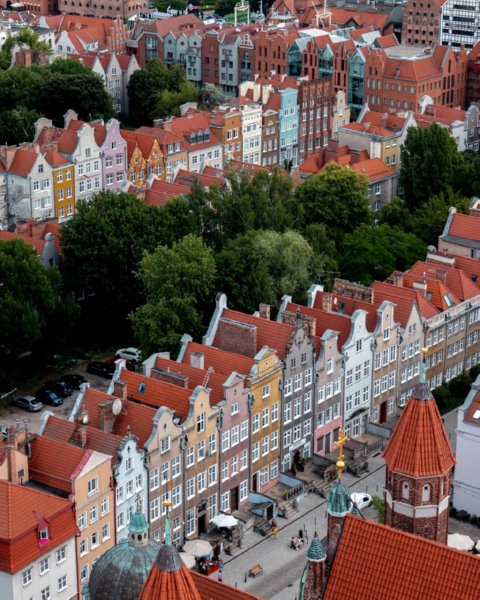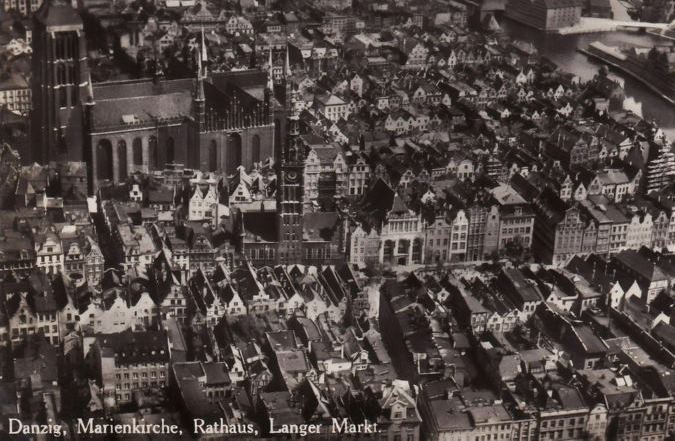Does anyone have anything else?
The Beer Flowing Gdańsk: from Gdańsk piwem płynący.
Beer indirectly contributed to the development of science in Gdańsk - if not for the income derived from its brewing, Johannes Hevelius could never afford his astronomical research.
en.wikipedia.org/wiki/Johannes_Hevelius
At the turn of the thirteenth and fourteenth centuries large European cities have been receiving special royal privileges, allowing brewing. Brewers, fearing unfair competition, quickly joined in guilds to keep an eye on product quality and protect the market against bunglers. Already in 1378 Gdańsk and Mazovian manufacturers of beer came to sharp conflict.
Beer produced in Gdańsk belonged to one of the four kinds.
Jopen beer, Jopenbier, Piwo Jopejskie
pl.wikipedia.org/wiki/Piwo_jopejskie
the noblest of all, was produced from 1449. Its name came from the wooden bucket, so called "jopa" (German Schöpfkelle), used in the process of brewing, to pour hot water to malt. It was "dubeltowe" (of double strength), which means that twice as much of malt and four times of hops was used than in other beers. It had about 14 percent of alcohol, dark colour, tarry texture, resembling a thick syrup. Some drinkers used to dilute it by mixing it with poorer quality beers. It was also used as a medicine causing sweating.
The secret of Jopen Beer was in its brewing process. First of all it was made with the best quality ingredients. Brewing lasted ten hours, not three, as with other beers. Then the brew had to be cooled rapidly, which meant that the peak production fell in the winter months. The biggest secret was its specific fermentation process. Someone had the idea that mold could be used instead of yeast - with this difference that it was not added directly to the brew - the beer aged in clean tubs, and mold made its work from the walls of the room. Jopen beer fermented up to nine weeks in sheds or cellars overgrown with mold. Then it matured in barrels for one year.
Jopen Beer was exported to many countries in Europe, mainly to England. To facilitate loading of beer kegs into ships' cargo holds the famous Żuraw (German Krantor), Gdańsk Port Crane was built.
pl.wikipedia.org/wiki/Brama_%C5%BBuraw_w_Gda%C5%84sku
Gdańsk Beer, Danzigerbier, was the second in terms of refinement. It was very popular because of the abundant froth and light bitter taste. It was also much weaker than Jopen Beer, because it contained only about 6 percent of alcohol.
Table Beer, Tafelbier was a common daily drink.
Krolling was the worst kind of Gdańsk's beers. It was made from beer keg washings. It was cheap, with low alcoholic content and was drunk by the poor.
In the year 1416 the most, as many as seventy-three brewers, lived at Hundegasse, Ogarna street today. Around the year 1620 when the seat of the brewers guild was located at Hundegasse 11.
Since the beginning of the sixteenth century beer production started moving out of Gdańsk center to the suburbs - Biskupia Górka (Bishops Hill), Chełm, and Stare Szkoty (Old Scots). During this period, much of the brewing industry was run by Dutch Mennonites. In the sixteenth century one of the largest brewers in Gdańsk and Pomerania belonged Schröders family: Hans, Joachim and Georg.
In the sixteenth century the brewers guild had 150 members, but barely 54 brewers in the middle of the seventeenth century. The brewing industry crisis brought the annual production from 150 thousand barrels down to a mere 50 000 (standard barrel held 126 liters).
In 1621 alone 34 breweries bankrupted.
One of the exceptions in these critical times was Johannes Hevelius brewery. The astronomer was a brewer by family tradition. His ancestors came from Ottendorf in 1434 and settled in Steblewo, then moved to Gdansk in 1526. They were initially engaged in commerce. Later, Hevelius grandfather, Nicholas, and his brother, founded their first brewery. Already in the mid-sixteenth century Hevelius family owned 12 breweries, including the largest one in the city.
When Johannes Hevelius married in 1635 Catherine Rebeschke, a daughter of another brewer, she has brought him a dowry of two houses adjacent to the Hevelius house at Korzenna Street (Spice Street). In one of them was a brewery, which Johannes began to manage. He was soon admitted to the Gdansk brewers guild, and thus earned the right to brewing and selling beer. He was quickly promoted to Senior of the guild, and in 1648, after the death of his father, he inherited the family house and was finally able to combine his father's and his wife's business into one large brewing company. The three adjacent houses, with the brewery, were the apple of the eye and the financial basis of the astronomer.
Where was beer drunk in the seventeenth century? Most pubs and taverns were located along the Motława river. These premises were popular with the common people and artisans, but were avoided by the patricians and nobles. The most elegant restaurants were in the suburbs. The inns lured travelers with recognizable symbols: of panicles made of spruce or fir branches. A panicle meant one thing: you can eat here, and - above all - drink something good.
Apparently, the best beer was administered in Gęsia Karczma (Goose Inn), Trzy Świńskie £by (Three Pig Heads) and Jerusalem.


